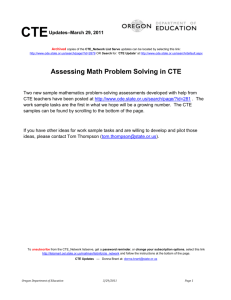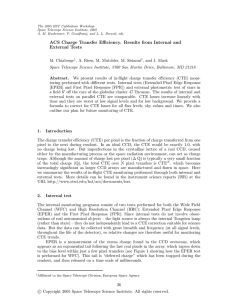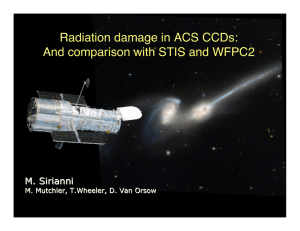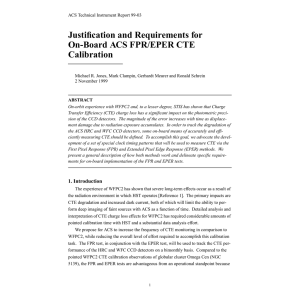ACS after Hubble Servicing Mission 4: CTE measurements
advertisement
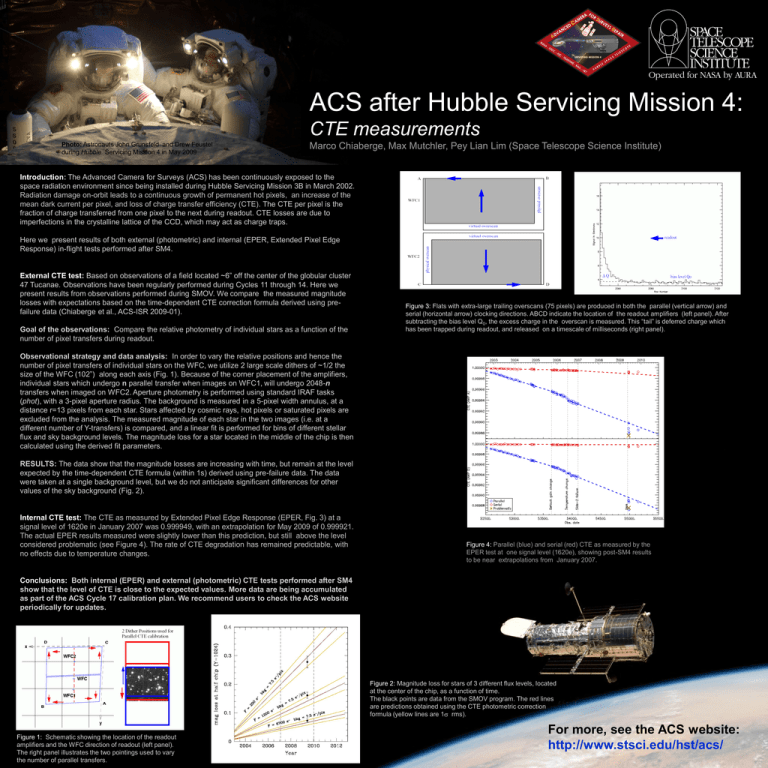
ACS after Hubble Servicing Mission 4: CTE measurements Photo: Astronauts John Grunsfeld and Drew Feustel during Hubble Servicing Mission 4 in May 2009 Marco Chiaberge, Max Mutchler, Pey Lian Lim (Space Telescope Science Institute) Introduction: The Advanced Camera for Surveys (ACS) has been continuously exposed to the space radiation environment since being installed during Hubble Servicing Mission 3B in March 2002. Radiation damage on-orbit leads to a continuous growth of permanent hot pixels, an increase of the mean dark current per pixel, and loss of charge transfer efficiency (CTE). The CTE per pixel is the fraction of charge transferred from one pixel to the next during readout. CTE losses are due to imperfections in the crystalline lattice of the CCD, which may act as charge traps. Here we present results of both external (photometric) and internal (EPER, Extended Pixel Edge Response) in-flight tests performed after SM4. External CTE test: Based on observations of a field located ~6” off the center of the globular cluster 47 Tucanae. Observations have been regularly performed during Cycles 11 through 14. Here we present results from observations performed during SMOV. We compare the measured magnitude losses with expectations based on the time-dependent CTE correction formula derived using prefailure data (Chiaberge et al., ACS-ISR 2009-01). Goal of the observations: Compare the relative photometry of individual stars as a function of the number of pixel transfers during readout. Figure 3: Flats with extra-large trailing overscans (75 pixels) are produced in both the parallel (vertical arrow) and serial (horizontal arrow) clocking directions. ABCD indicate the location of the readout amplifiers (left panel). After subtracting the bias level Q0, the excess charge in the overscan is measured. This “tail” is deferred charge which has been trapped during readout, and released on a timescale of milliseconds (right panel). Observational strategy and data analysis: In order to vary the relative positions and hence the number of pixel transfers of individual stars on the WFC, we utilize 2 large scale dithers of ~1/2 the size of the WFC (102”) along each axis (Fig. 1). Because of the corner placement of the amplifiers, individual stars which undergo n parallel transfer when images on WFC1, will undergo 2048-n transfers when imaged on WFC2. Aperture photometry is performed using standard IRAF tasks (phot), with a 3-pixel aperture radius. The background is measured in a 5-pixel width annulus, at a distance r=13 pixels from each star. Stars affected by cosmic rays, hot pixels or saturated pixels are excluded from the analysis. The measured magnitude of each star in the two images (i.e. at a different number of Y-transfers) is compared, and a linear fit is performed for bins of different stellar flux and sky background levels. The magnitude loss for a star located in the middle of the chip is then calculated using the derived fit parameters. RESULTS: The data show that the magnitude losses are increasing with time, but remain at the level expected by the time-dependent CTE formula (within 1s) derived using pre-failure data. The data were taken at a single background level, but we do not anticipate significant differences for other values of the sky background (Fig. 2). Internal CTE test: The CTE as measured by Extended Pixel Edge Response (EPER, Fig. 3) at a signal level of 1620e in January 2007 was 0.999949, with an extrapolation for May 2009 of 0.999921. The actual EPER results measured were slightly lower than this prediction, but still above the level considered problematic (see Figure 4). The rate of CTE degradation has remained predictable, with no effects due to temperature changes. Figure 4: Parallel (blue) and serial (red) CTE as measured by the EPER test at one signal level (1620e), showing post-SM4 results to be near extrapolations from January 2007. Conclusions: Both internal (EPER) and external (photometric) CTE tests performed after SM4 show that the level of CTE is close to the expected values. More data are being accumulated as part of the ACS Cycle 17 calibration plan. We recommend users to check the ACS website periodically for updates. Figure 2: Magnitude loss for stars of 3 different flux levels, located at the center of the chip, as a function of time. The black points are data from the SMOV program. The red lines are predictions obtained using the CTE photometric correction formula (yellow lines are 1 rms). Figure 1: Schematic showing the location of the readout amplifiers and the WFC direction of readout (left panel). The right panel illustrates the two pointings used to vary the number of parallel transfers. For more, see the ACS website: http://www.stsci.edu/hst/acs/




